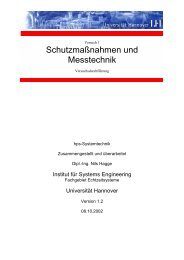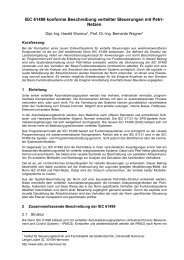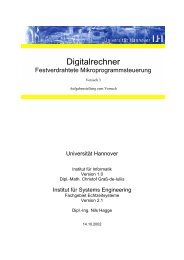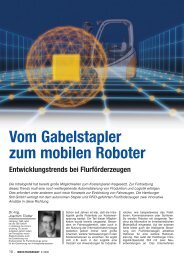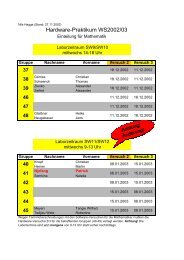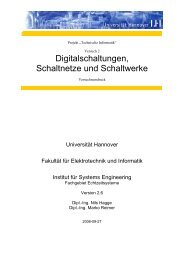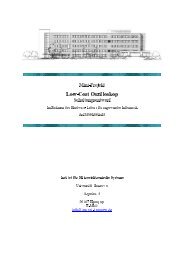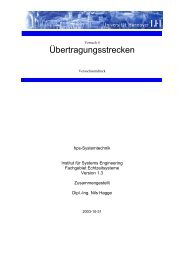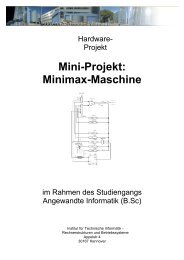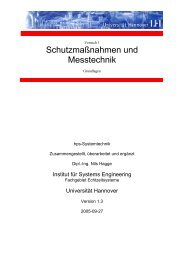FAST 3D SCANNING METHODS FOR LASER MEASUREMENT ...
FAST 3D SCANNING METHODS FOR LASER MEASUREMENT ...
FAST 3D SCANNING METHODS FOR LASER MEASUREMENT ...
You also want an ePaper? Increase the reach of your titles
YUMPU automatically turns print PDFs into web optimized ePapers that Google loves.
<strong>FAST</strong> <strong>3D</strong> <strong>SCANNING</strong> <strong>METHODS</strong> <strong>FOR</strong> <strong>LASER</strong> <strong>MEASUREMENT</strong> SYSTEMS<br />
Oliver Wulf, Bernardo Wagner<br />
Institute for Systems Engineering, University of Hannover, Germany<br />
Email: {wulf,wagner}@rts.uni-hannover.de<br />
Abstract: <strong>3D</strong> perception is a promising technology for automatic control, manufacturing<br />
and robotics. Compared to 2D vision systems <strong>3D</strong> range sensors can provide direct geometric<br />
information of the environment. This paper describes <strong>3D</strong> scanning systems with<br />
laser time-of-flight measurement devices and compares their usability in different application<br />
scenes. Additionally new methods that allow fast scanning are contributed. Optimizations<br />
are based on efficient scanning methods with a maximum number of measurement<br />
points in the area of interest, compensation of systematic measurement errors<br />
and improvements of the mechanical scanning system. All described methods are implemented<br />
and tested on a mobile robot with a real-time Linux system.<br />
Keywords: Data Acquisition Systems, <strong>3D</strong> Perception, Laser Range Finder, LMS<br />
1. INTRODUCTION<br />
There are a number of ways to acquire 3-<br />
Dimensional information of the environment. Measuring<br />
methods can be divided into three major principles,<br />
stereo vision (e.g. with application in robotics,<br />
Lacroix et al., 2002), active triangulation (e.g. in<br />
quality control, Perceptron, 2003) and laser time-offlight<br />
measurement (see below). Each method has its<br />
advantages and drawbacks and is therefore suitable<br />
for different applications.<br />
The laser time-of-flight method, that will be dealt<br />
with in this paper, is robust and can provide distance<br />
measurements in a range of more than 50m with<br />
centimeter accuracy. As the measurement device is<br />
1-Dimensional a scanning mirror is needed to get 2D<br />
or <strong>3D</strong> data. Commercial 2D sensors that work on this<br />
principle are available and widely used. On the other<br />
hand there is no commercial <strong>3D</strong> scanner available<br />
that is suitable for applications in dynamic environments.<br />
Laser scanners that are used in surveying (for<br />
example Riegl, 2001) do not fulfill the needs of factory<br />
automation and robotics, as they are heavy,<br />
expensive and the scan time is by far too long (a few<br />
minutes).<br />
A common solution to make <strong>3D</strong> scanning feasible for<br />
this kind of applications is to use a standard 2D scanner<br />
and a mechanical actuator to reach the 3 rd dimension.<br />
The actuator can be a servo drive to turn the<br />
scanner (Surmann et al., 2001 and Hähnel and Burgard,<br />
2002).<br />
The combination of a 2D laser scanner and a servo<br />
drive (fig. 1) allows different arrangements of scan<br />
planes and rotation axis that lead to different fields of<br />
view. Additionally, rotation around one axis leads to<br />
high measurement densities close to this axis. Depending<br />
on the scanning method, this density distribution<br />
can focus on a special area of interest or lead<br />
to a bad exploitation of the scan capabilities.<br />
The scanning time for this kind of sensor setup is<br />
usually more than 10s. But if the sensor is not supposed<br />
to be used for static modeling the measurement<br />
time has to be as short as possible. <strong>3D</strong> scanners to be<br />
used in factory automation or on moving mobile<br />
platforms need even shorter scanning times. This<br />
paper shows methods that enable fast <strong>3D</strong> raw data<br />
acquisition by efficient use of the available hardware.<br />
The improvements are made by choosing appropriate<br />
scanning methods (section 2), compensation of systematic<br />
measurement errors (section 3) and mechanical<br />
improvements of the scan device (section 4).
c)<br />
Fig. 1. <strong>3D</strong> scanner (yawing scan) consisting of a 2D laser<br />
range sensor (Sick) and a servo drive (Powercube)<br />
d)<br />
2. <strong>SCANNING</strong> <strong>METHODS</strong><br />
An obvious optimization of the measurement system<br />
is to take the scanning method that is most suitable<br />
for the application. However, taking a 2D laser scanner<br />
with 180° scanning range and a servo drive results<br />
in a number of possible combinations of scan<br />
planes and rotation axis to get a <strong>3D</strong> scan. This section<br />
describes four of these combinations. Subsection 2.1<br />
gives a graphical analysis showing the measurement<br />
density distributions. Based on this analysis and<br />
experimental results the scanning methods are compared<br />
in 2.2.<br />
We have named the scanning methods as pitching<br />
scan, rolling scan, yawing scan and yawing scan top.<br />
The pitching scan (Fig. 2a) has a horizontal scan<br />
plane and is pitching up and down. This method is<br />
for example used in Surmann et al. (2001) and Hähnel<br />
and Burgard (2002). A method that is newly<br />
introduced here is the rolling scan (Fig. 2b). This<br />
scan is rotating around the center of the scanner, with<br />
the advantage of only one focus point in front of the<br />
sensor. The yawing scan (Fig. 2c) and the yawing<br />
scan top (Fig. 2d) have a vertical scan plane and are<br />
rotating around the upright z-axis. This method is<br />
used e.g. by Riegl (2001).<br />
a)<br />
b)<br />
Fig. 2. Scanning schemes (left) and measurement density<br />
distribution (right): (a) pitching scan, (b) rolling scan, (c)<br />
yawing scan and (d) yawing scan top<br />
2.1 Measurement density<br />
As described above, variations of the rotation axis<br />
and the alignment of the 2D scanner lead to a number<br />
of different scanning patterns. On one hand these<br />
scanning patterns differ in the field of view that can<br />
be specified by a horizontal apex angel, a vertical<br />
apex angel and the center of the scan. On the other<br />
hand they differ in the distribution of the distance<br />
measurements. Compared to a camera e.g. the measured<br />
points are not placed in a regular grid. The rotation<br />
of the 2D sensor leads to an accumulation of<br />
scan points along the rotation axis that lead to a non<br />
homogeneous measurement density distribution. The<br />
measurement density is minimal for laser beams<br />
orthogonal to the rotation axis and maximal for<br />
beams parallel to this axis.<br />
One possibility to illustrate the measurement density<br />
distribution and the field of view, that is spanned by<br />
the apex angles, is to show the measurement points<br />
on a virtual sphere surrounding the <strong>3D</strong> scanner. The<br />
right column of figure 2 shows this method applied to<br />
the described scanning patterns. It can be seen, for<br />
example, that the pitching scan (fig. 2a) has got two<br />
regions with a high measurement density on both<br />
sides of the scanner and the rolling scan (fig. 2b) one<br />
large region with a high density in front of the sensor.<br />
These illustrations can be used for a qualitative comparison<br />
of different scanning patterns.<br />
2.2 Experimental comparison<br />
This subsection shows experimental results of all<br />
four scanning methods. The results illustrate the<br />
meaning of the measurement density distribution in<br />
real environments. Based on these results the practicability<br />
in different applications is briefly discussed.<br />
The examples are chosen from our mobile robotics<br />
background, but similar scenarios can also be found<br />
in other parts of flexible automation. Furthermore the
goal of this subsection is to illustrate the amount of<br />
information and the potential that lies in <strong>3D</strong> sensing.<br />
The first experiment was made in a simple indoor<br />
environment. It shows a person standing in the corridor<br />
of our lab. Even though the scans shown in figure<br />
3a and 3b took the same scanning time (1.6s), and<br />
therefore consist of the same amount of points (about<br />
22000), the scans are very different. It can be seen<br />
that the measurement points are not uniformly distributed.<br />
The pitching scan (fig. 3a) contains two<br />
regions with a large number of points on the walls to<br />
the left and the right side of the scanner, whereas the<br />
person in front of the scanner is only sensed with a<br />
few measurement points. On the other hand the rolling<br />
scan (fig. 3b) centers most of its measurement<br />
points in one region in front of the scanner and only a<br />
few points along the walls on the side. Here, the<br />
representation of the person in front of the sensor is<br />
more detailed.<br />
measured geometric information can be used directly<br />
to estimate the container position, orientation and<br />
height. The applicable scanning methods are also<br />
depending on the required field of view. But in contrast<br />
to the application in safety systems the rolling<br />
scan might not be preferred to the pitching scan or<br />
yawing scan. In measurement applications the regular<br />
structure consisting of horizontal rows and vertical<br />
columns might be easier to handle in following data<br />
processing steps (segmentation, object detection).<br />
Anyway the measurement points on the sides of the<br />
scanner would be wasted in this case.<br />
a)<br />
a)<br />
b)<br />
b)<br />
Fig. 3 Corridor with standing person: (a) pitching scan<br />
(1.6s), (b) rolling scan (1.6s)<br />
One possible application of <strong>3D</strong> scanners is to build<br />
up safety systems. These systems can be used for<br />
area protection in factory automation, collision<br />
avoidance on mobile robots or in surveillance. In this<br />
applications the scanning method is first of all depending<br />
on the needed field of view. For applications<br />
with a horizontal apex angle of less then 180° the<br />
pitching scan, the yawing scan or the rolling scan are<br />
applicable, whereby the rolling scan has got the most<br />
measurement points in the area of interest in front of<br />
the sensor. In case that a larger apex angel is needed,<br />
only the yawing scan and the yawing scan top are<br />
applicable.<br />
A more advanced application for <strong>3D</strong> laser scanners is<br />
a measurement system for object localization and<br />
recognition. An example scan for this kind of application<br />
can be seen in figure 4a showing a ramp and<br />
two containers. In the top view calculated from the<br />
same scan (fig. 4b) the different nature of 2D camera<br />
pictures and <strong>3D</strong> range scans becomes clear. The<br />
Fig. 4 Position estimation of a ramp and 2 containers:<br />
(a) pitching scan side view, (b) top view<br />
Another, more specialized application for laser scanners<br />
is mobile robot navigation in indoor environments,<br />
including localization and mapping. There are<br />
a number of solutions that manage this navigation<br />
task by using 2D laser sensors and maps build of<br />
simple features like lines or corners. These algorithms<br />
work well under the condition that enough<br />
straight wall segments can be seen. But this precondition<br />
excludes packed rooms and environments with<br />
many people. As walls in different heights and the<br />
ceiling can be seen in <strong>3D</strong> scans, the information<br />
content of <strong>3D</strong> scans offers a potential solution for<br />
navigation problems in this kind of environments.<br />
Figure 5a shows a yawing scan top of a packed room.<br />
In contrast to the 2D scan taken in the same room<br />
(fig. 5b), large parts of the walls and the ceiling can<br />
be seen. In this special kind of application the yawing<br />
scan top would be the most suitable scanning<br />
method. With its 360° apex angle and perception of<br />
the whole upper hemisphere, this scanning method<br />
covers 100% of the area of interest in flat indoor<br />
environments.
a)<br />
b)<br />
Fig. 5 <strong>3D</strong> scan for indoor navigation: (a) yawing scan top<br />
(2.8s), (b) 2D scan of the same room<br />
To complete the list of scanning methods, the experiments<br />
that can be seen in figure 6a and 6b show<br />
<strong>3D</strong> scans measured with the yawing scan method.<br />
The advantage of this scanning method is that it is<br />
possible to make scans with a horizontal apex angel<br />
larger than 180°. This wide opening angle is for example<br />
useful in outdoor navigation of mobile robots.<br />
a)<br />
b)<br />
Fig. 6 Yawing scan (270°, 4s) in outdoor application:<br />
(a) avenue (b) car park<br />
3. SYSTEMATIC <strong>MEASUREMENT</strong> ERRORS<br />
The analysis of systematic measurement errors and<br />
the compensation of these effects play an important<br />
role in <strong>3D</strong> scanning. Here the synchronization of the<br />
laser device and the position of the servo drive have a<br />
major influence on the accuracy of the <strong>3D</strong> point<br />
cloud, as it is already mentioned in Herbert and<br />
Krotkov (1991). Especially fast scanning is effected<br />
by poor synchronization, as it can be seen in the<br />
following example: A <strong>3D</strong> scanning device with the<br />
commonly used Sick LMS 200 and a 1° resolution<br />
results in a rotation speed ω s = 75° / s of the servo<br />
drive. The maximum systematic measurement error<br />
e due to a miss synchronization of ∆ t = 100ms<br />
and<br />
an object distance of d = 10m<br />
can be estimated as<br />
follows:<br />
( ⋅ t)<br />
e = d ⋅sin ωs ∆<br />
(3.1)<br />
resulting in a maximal systematic measurement error<br />
with a magnitude of e = 1. 3m<br />
for a typical non realtime<br />
system.<br />
Subsection 3.1 describes a real-time implementation<br />
and a method to build time consistent data sets. Subsection<br />
3.2 describes how the Sick LMS 200 creates<br />
its 0.5° resolution. The understanding of this function<br />
leads to better time correlation and therefore better<br />
accuracy.<br />
3.1 Time-consistent data sets<br />
A common representation for <strong>3D</strong> measurements is<br />
the <strong>3D</strong> point cloud given in Cartesian coordinates (as<br />
seen in fig. 3 – 6). To calculate this <strong>3D</strong> point cloud a<br />
transformation is needed that has the 2D raw scan<br />
and the position of the 2D scanner as its inputs. As it<br />
was already stated in the beginning of this section, it<br />
is important that the scanner position at the time of<br />
the scan is known. This means that a time consistent<br />
data set, consisting of a laser scan and the servo drive<br />
position is needed.<br />
One way to get this data set is a sequential data capturing<br />
procedure that waits for a new laser scan and<br />
reads the servo drive position afterwards. The problem<br />
with this simple procedure is that the acquired<br />
data set is not time consistent. In this case the servo<br />
drive position is not specifying the scanner position<br />
at the time of the scan, but its position a short time<br />
after. This “short” time is system dependent and can<br />
be up to several 100 ms due to a servo drive that<br />
gives only time discrete response or a non real-time<br />
OS that is delayed by hard disk I/O or memory arrangements.<br />
A possibility to overcome this problem is a different<br />
data capturing procedure for real-time operating<br />
systems. This data acquisition system consists of<br />
three tasks. Two of these tasks read continuous data<br />
from the laser scanner and the servo drive, where<br />
these tasks must neither be synchronized nor have the<br />
same sampling frequency (fig. 7). The correlation is<br />
made subsequently based on accurate timestamps<br />
that are attached to each raw data sample. The third<br />
task connects this raw data to get a time consistent<br />
data set and to calculate the transformation into Cartesian<br />
coordinates. As this calculation is only based<br />
on the given timestamps, the third task is not time<br />
critical and can be performed with low priority, remote<br />
or even offline without loss of precision.<br />
Given the accurate timestamps, the actual assembly<br />
procedure is fairly easy. The third task waits for a<br />
new 2D laser data package and looks up the accord-
ing position in a list of received servo drive positions.<br />
Because the position at the accurate scan time is not<br />
generally given, the position can be linearly interpolated<br />
between the two closest servo drive positions<br />
(fig. 7). For efficient calculation our actual implementation<br />
is representing a 2D laser scan by a single<br />
timestamp which leads to a maximal miss synchronization<br />
of ∆ t = 3. 3ms<br />
for the measured points at the<br />
beginning and the end of the scan. For slower 2D<br />
scanners (longer ∆ t ) or faster <strong>3D</strong> scans (larger ω S ),<br />
it might be necessary to represent the 2D scans with<br />
start- and end-timestamps and to interpolate the laser<br />
measurement point of time as well.<br />
resulting in an angle resolution of ∆ϕ = 1°<br />
for the<br />
scanner with f L = 27kHz<br />
sampling rate and a rotation<br />
speed of ωm = 75⋅<br />
2π<br />
/ s (13.3ms turnaround<br />
time). If the maximum sampling rate is fixed an angular<br />
resolution of 0.5° or 0.25° can be reached in<br />
two different ways. One possibility is, according to<br />
equation 3.2, a lower mirror speed, resulting in a turn<br />
around time of 26.6ms for 0.5° and 53.3ms for 0.25°<br />
resolution. The second possibility, which is applied<br />
in the sick sensor, is to assemble the 0.5° scan out of<br />
two scans with 1° resolution. Here, the mirror is<br />
constantly rotating with a speed of ωm = 75⋅<br />
2π<br />
/ s<br />
and is measuring the first scan with 1° resolution and<br />
0° offset and the second scan also with a resolution<br />
of 1° but an offset of 0.5° (Fig. 8). Similarly the<br />
0.25° resolution takes four turns with 0.0°, 0.5°,<br />
0.25° and 0.75° offsets. This scanning pattern does<br />
not affect the scanning time or the accuracy of static<br />
scans but it disturbs fast <strong>3D</strong> scan, as an exact measurement<br />
timestamp cannot be given. For this case the<br />
Sick raw data mode offers a good solution. This<br />
measuring mode uses the same scanning pattern to<br />
generate the 0.5° resolution but in contrast to the<br />
standard mode, which measures two turns and transmits<br />
a 0.5° data package thereafter, the raw data<br />
mode transmits two 1° data packages directly after<br />
the measurement. This allows more accurate timestamps<br />
and therefore better compensation of systematic<br />
measurement errors.<br />
Fig. 7. Synchronization of laser scanner and servo drive<br />
Fig. 8. Sick LMS Raw Data Mode<br />
3.2 Sick LMS Raw Data Mode<br />
To assign accurate timestamps and to compensate<br />
systematic measurement errors, knowledge about the<br />
measurement principle and the actual implementation<br />
of the sensor is needed. As the implementation is<br />
sensor dependent, this paper takes the LMS 200 series<br />
of the company Sick as an example. This 2D<br />
laser range scanner is a standard industrial product<br />
which is widely used in robotics.<br />
The Sick 2D scanner, similarly to other sensors,<br />
consists of a 1D laser range measurement device and<br />
a continuously rotating mirror. The 180° opening<br />
angle of the sensor is separating the measurement<br />
stream into two equal sized time slots. One measurement<br />
slot and one slot where no measurements are<br />
possible because the mirror is facing the inside of the<br />
case. This timeslot is used for communication and<br />
data transfer. The angle resolution ∆ ϕ can be calculated<br />
from the sampling rate f L and the rotation<br />
speed of the mirror ω as follows:<br />
m<br />
ωm<br />
∆ ϕ =<br />
(3.2)<br />
f<br />
L<br />
4. CONTINUOUS <strong>SCANNING</strong><br />
All <strong>3D</strong> scans that have been presented in this paper<br />
so far and all publications concerning <strong>3D</strong> scanners<br />
consisting of a 2D laser scanner and an extra servo<br />
drive use a servo drive with limited turning circle.<br />
This limitation is due to the cable connections of the<br />
laser sensor for power supply and data transfer. The<br />
problem of the limited turning circle is that the scanner<br />
cannot be turned with constant speed. The sensor<br />
has to be accelerated at the start and the end of each<br />
turn. This accelerations can lead to mechanical problems<br />
especially on fast scans. On one hand the lifetime<br />
and mechanical stability of the sensor is reduced<br />
due to the forces that come with the positive and<br />
negative acceleration, on the other hand the servo<br />
drive has to be more powerful and requires more<br />
energy compared to a continuously moving scanner,<br />
a drawback especially on mobile systems.<br />
Fig. 9. Scan drive prototype with<br />
IBEO 2D range finder<br />
A solution for this problem, that has been build as a<br />
prototype (fig. 9) at the institute, is a <strong>3D</strong> scanner with<br />
a continuously moving servo drive. To enable this<br />
endless turning, it is necessary to replace the cable<br />
connections for power and data transfer by slip rings.<br />
For this reason the implemented prototype has got a 4<br />
pole slip ring with 2 poles for 24V power supply and<br />
2 poles for data transfer via 1Mbit CAN bus.
Fig. 10. Range image taken with the<br />
continuously turning <strong>3D</strong> scanner<br />
Riegl Laser Measurement Systems (2001). Data<br />
sheet, LMS-Z210, www.riegl.com<br />
Sick AG (2000). Data sheet, LMS 200,<br />
www.sick.com<br />
Surmann, H., K. Lingemann, A. Nüchter and J.<br />
Hertzberg (2001). A <strong>3D</strong> Laser Range Finder for<br />
Autonomous Mobile Robots, In: Proceedings of the<br />
International Symposium on Robotics, Zurich, Switzerland<br />
5. CONCLUSION<br />
This paper described a sensor system that is able to<br />
acquire <strong>3D</strong> geometric information of the environment.<br />
The system consists of a 2D laser range sensor<br />
working on the time-of-flight measurement principle,<br />
a servo drive as mechanical actuator and a processing<br />
unit that collects raw data and calculates point clouds<br />
in Cartesian space.<br />
The focus of this paper lies on the fast acquisition of<br />
undistorted raw data that allows the use of <strong>3D</strong> sensors<br />
in safety systems, factory automation and on<br />
moving platforms like service robots. All scanning<br />
<strong>3D</strong> sensors that are available at present can only be<br />
used for static modeling as the measurement of one<br />
scan takes several minutes. Even the <strong>3D</strong> scanners that<br />
are used on mobile robots need more than 10s to take<br />
a single scan with an apex angle of 180 ° × 90°<br />
.<br />
This paper described improvements that allow fast<br />
scanning. The contributions are made by laying a<br />
focus on the measurement density distribution, by<br />
compensation of systematic measurement errors and<br />
by mechanical improvements of the scanning device.<br />
These improvements allow fast scanning with scan<br />
times from 1.6s for an apex angle of 180 ° × 180°<br />
to 5<br />
seconds for 360 ° × 180°<br />
without distortion. The only<br />
limiting factor at this moment is the maximum measurement<br />
rate of the available 2D scanners. Thus the<br />
scanner can be used in dynamic environments and<br />
not only for static modeling.<br />
REFERENCES<br />
Hähnel, D. and W. Burgard (2002). Map Building<br />
with Mobile Robots in Populated Environments, In:<br />
Proceedings of the International conference on Intelligent<br />
Robots and Systems, Lausanne, Switzerland<br />
Herbert, M. and E. Krotkov (1991). 3-D Measurements<br />
from Imaging Laser Radars: How good are<br />
they?, In: Proceedings of the International Workshop<br />
on Intelligent Robots and Systems, Osaka, Japan<br />
Lacroix, S., A. Mallet, D. Bonnafous, G. Bauzil, S.<br />
Fleury, M. Herrb and R. Chatila (2002). Autonomous<br />
Rover Navigation on Uneven Terrains: Functions<br />
and Integration, International Journal of Robotics<br />
Research, Volume No 21, pp. 917 - 942<br />
Perceptron (2003). ScanWorks <strong>3D</strong> product Brochure,<br />
www.perceptron.com




